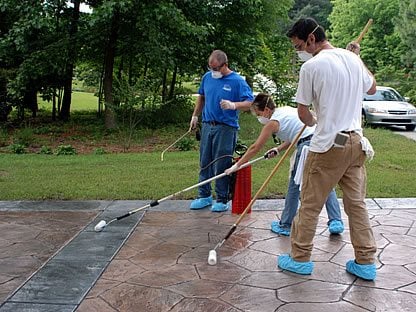- Concrete Stamps
- Get the Look - Stamping Pictures
- Buying Tips for Concrete Stamping Tools: Advice that will help you make smart choices
- Concrete Stamp Cost
- Types of Concrete Stamps: A comparison chart of popular stamps & patterns
- Stamping & Texturing Tools
- Concrete Stamp Mats
- Concrete Texturing Skins
- Medallion Stamps
- Texture Rollers
- Step Forms & Liners
- Installing Stamped Concrete
- How to Stamp Concrete
- Coloring Stamped Concrete
- Concrete Stamp Release Agent
- Sealers for Stamped Concrete
The Best Sealers for Stamped Concrete
What type of sealer should be used for sealing stamped concrete?The final step in the installation of stamped concrete is to apply a concrete sealer suitable for exterior exposure conditions. Sealers provide several important benefits:
- They block the penetration of stains, oil, deicing chemicals and other contaminants.
- They protect stamped concrete surfaces from abrasion and wear.
- The make stamped concrete easier to clean and maintain.
- They enrich the color intensity of stamped concrete, whether the color is integral or provided by a dry-shake hardener and antiquing release.
- They add sheen to the surface, ranging from satin to high gloss.
How to choose the best sealer for stamped concreteThe primary type of sealer used for exterior stamped concrete flatwork is a solvent- or water-based acrylic. Acrylic sealers are easy to apply, economical, and most important, breathable, allowing moisture in the slab to escape. They also are UV resistant and non-yellowing. Solvent-based acrylics generally perform better than water-based products for outdoor use because they penetrate well and are less likely to turn white, or milky. (Learn more about acrylic sealers.)
Before buying a sealer, check with the manufacturer to make sure the product is appropriate for your particular project. Here are some important questions to ask:
- What conditions will the sealer be exposed to?
- Is the sealer breathable?
- What is the drying time?
- What is the coverage rate?
- What type of finish and surface appearance do you want to achieve?
- What is the life expectancy of the sealer, and does the manufacturer provide a warranty?
- How easy is the sealer to apply?
- See more frequently asked questions here.
 Clear-Seal by Increte Systems
Seals and protects decorative surfaces.
Clear-Seal by Increte Systems
Seals and protects decorative surfaces.
 Premium Exterior Clear Sealer
High solids acrylic based sealer
Premium Exterior Clear Sealer
High solids acrylic based sealer
 Bluestone Texturing Skin
6 skin set - only $1,173.20
Bluestone Texturing Skin
6 skin set - only $1,173.20
 Five Point Star Medallion
Concrete stamp only - $292.00
Five Point Star Medallion
Concrete stamp only - $292.00
 Brickform Stamping Tools
Precision stamping tools
Brickform Stamping Tools
Precision stamping tools
How to seal stamped concreteBefore applying sealer to stamped concrete, the surface must be clean and dry to ensure good adhesion. Also, you should allow the concrete to cure sufficiently -- generally several weeks after placement, depending on weather conditions. With stamped concrete, it’s especially important to make sure the surface is free of moisture in low spots of the stamp pattern, where water may accumulate.
Find concrete contractors near me that can help seal my stamped concrete.
There are several tools you can use to apply sealer to stamped concrete, depending on the product you’re using. Pump-up or low-pressure sprayers are best for applying one-part, solvent-based sealers with a solids content below 35%. Airless, or low-pressure high-volume (LPHV) sprayers, can handle both water- and solvent-based sealers and permit very controlled application rates, allowing large areas to be sealed in the shortest time. You can also apply water- or solvent-based sealers with a paint-type roller. To work the sealer into the textured surface and stamp pattern depressions, be sure to use a roller with a fairly thick nap (about 3/8 inch). One of the best application techniques when sealing stamped or textured surfaces is to combine spraying followed back rolling to keep the sealer from settling in low spots and to help distribute the sealer uniformly.
Learn more about choosing the best applicator for concrete sealer.
Stamped concrete sealer dos and don’ts
- DON’T apply the sealer too thickly, or it will just lie or puddle on the surface rather than penetrate. Acrylic sealers are designed to go down very thinly, at thicknesses of only 1 to 2 mils.
- DO apply sealer in two thin coats rather than one thick heavy coat to achieve more uniform coverage.
- DON’T apply a solvent-based sealer over a water-based product because the solvent can eat or soften the existing water-based sealer.
- DO refer to the sealer manufacturer's application guidelines for specifics on surface preparation, recommended application tools, and dry times between coats.
For more information on concrete sealer application and troubleshooting, see Fixing Common Sealer Problems.
Related resources:
Buyer's Guide to Concrete Sealers
Advice on Tinting Sealers
Video: Acrylic Concrete Sealer Application





